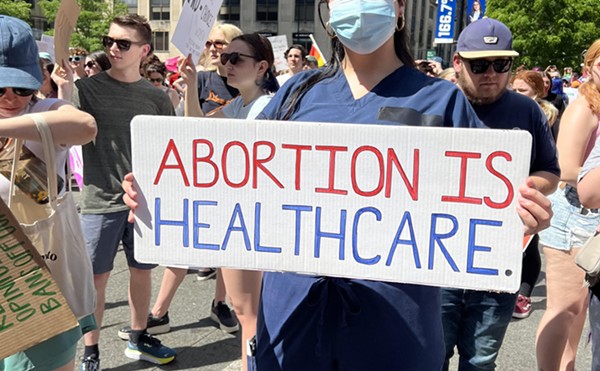June 7, 2003, is the day I've been waiting for. It's the day the Rosenthal Center for Contemporary Art opens its doors to the general public. So it's the day you and I and everyone else interested in contemporary art will find out what art fills the interior spaces of our brand new art venue.
June 7 is the day we learn if the Center lives up to its original 1939 mission, set forth by its three progressive female founders, to present current day art to anyone in Cincinnati who thirsted for knowledge about what, at that time, it meant to be "modern."
June 7 is the day when this city acts upon its potential, to renew this 64-year-old commitment, to be a true center for contemporary art.
In recent years, the focus has been on the building of the Center. Given the ambitious nature of this undertaking, that's what was necessary. Turning the building program, initially a dream of a few, into a reality for us all, has required vision, leadership, perseverance, tremendous architectural talent and, of course, lots of money.
Those of us who believed there was a lot at stake in this process of creating a new Contemporary Arts Center watched from the sidelines and listened. First, there was the debate over whether a new building was actually needed.
Then there was the competition for the architect. Once the architectural plan was unveiled, there was more talk about Zaha Hadid's lofty architectural program and the associated rising costs.
But there never seemed to be any conversation or information about what the exhibition program for the new building would be. There was never discussion about the true purpose of the new center and what the public was going to see, hear, experience and learn about once the doors were opened wide and all of us who live, work and play in this town were given a chance to enter.
So that's why June 7 is the day I've been waiting for.
From what I have discovered through pre-opening tours and advance information on the inaugural exhibition, June 7 is a day that will make all our aesthetic heartbeats quicken. It is the day when my personal aspirations regarding the true mission of this institution will be realized. On that day the Rosenthal Center will present the most ambitious exhibition of contemporary art that has ever occurred Cincinnati.
The Rosenthal Center's opening exhibition, Somewhere Better Than This Place: Alternative Social Experience in the Spaces of Contemporary Art, is a thematic group exhibition organized by the CAC's own curator, Thom Collins. The raw data on the exhibition, before even considering artistic intention, is as good as it gets.
The exhibition brings together the work of 35 artists or artistic teams. They hail originally from all corners of the globe: United States, Canada, United Kingdom, Italy, Sweden, Belgium, Spain, Germany, Japan, China, Soviet Union, South Korea, South Africa, Iran and Argentina. They range in age from early 60s to late 20s, with the vast majority of artists being in their 30s or early 40s. There is a balance of the sexes, as well as sexual preference.
The art included in Somewhere Better Than This Place is all recent, having been made in just the past few years; eight pieces have been created specifically for the exhibition. And the mediums favored by this extraordinary group are representative of what predominates in the larger art world — film, video, photography, installation, sculpture, performance and methods which blur the boundaries among these now fluid disciplines.
The theme and title of the exhibition was inspired by the artistic philosophy of artist Felix Gonzalez-Torres, an influential Cuban-American artist who died in 1996. Gonzalez-Torres embraced the notion that one must push for the beauty of the imagined life rather than settle for what the status quo offers. He created a work of art, included in the exhibition, that suggested that art and life can be about creating "somewhere better than this place," while simultaneously positing the contradictory viewpoint that in the course of a fully lived life there can be "no where better than this place."
As Collins gathered the artworks for Somewhere Better Than This Place, he sought out work that, according to his essay in the exhibition catalogue, created "social identities, social orders, and social relationships alternative to those dominant in the broader culture." He also favored artworks that achieved this through "participatory projects rather than merely illustrative means."
Collins' exhibition divides the art into four groups. I have taken the liberty of expanding upon his heady descriptors and have listed a few of the artists in their assigned categories.
Social Construction of Identities: Art that examines and confronts how the larger society promotes fixed ideas about race, gender and class, thereby influencing how we define ourselves and others. Sandford Biggers & Jennifer Zackin, Patty Chang and Byron Kim & Glenn Ligon.
Discourses of Social Order: Art that comments on various ideas about how our society is or can be organized and how this organization overtly and subversively affects our lives. Francis Alys, Mats Hjelm, Moshekwa Langa and Shirin Neshat.
Changing Patterns of Social Relations: Art that reflects upon changes taking place in society regarding how individuals and groups interact, particularly by scrutinizing the often unexamined rituals of daily life. Vanessa Beecroft, Rirkrit Tiravanija and Zhang Huan.
Social Encounters Organized Around Shared Experiences of the Sublime: Art that pushes the sensations of awe, fear and wonder from the realm of the personal and private into the public, where they can be shared and explored with others. Janet Cardiff, Komar & Melamid and Wolfgang Tillmans.
The artists and methodologies utilized in Somewhere Better Than This Place will be unfamiliar to many visitors. Traditional paintings and sculptures are nowhere to be found.
So on June 7 you can enter the Rosenthal Center ready to be challenged in every way possible.
Come prepared to embark on a journey of engagement with contemporary aesthetic ideas. Watch our city — through the new Rosenthal Center — embrace the culture of the 21st century.
JEAN E. FEINBERG is the former curator for modern art at the Cincinnati Art Museum.





